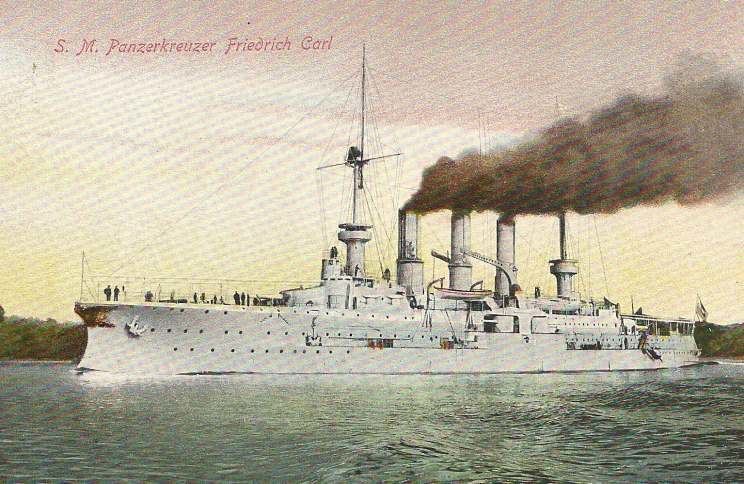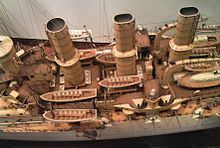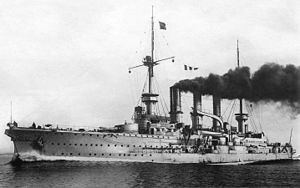Name Friedrich Carl Cost 15.665.000 mark Laid down 1900 Construction started 1900 Length 126 m | Namesake Prince Friedrich Carl Yard number 155 Commissioned 12 December 1903 Launched 21 June 1902 Builder Blohm + Voss | |
 | ||
SMS Friedrich Carl was a German armored cruiser built in the early 1900s for the Imperial German Navy. She was the second ship of the Prinz Adalbert class. Friedrich Carl was built in Blohm & Voss shipyard in Hamburg. She was laid down in 1901, and completed in December 1903, at the cost of 15,665,000 Marks. She was armed with a main battery of four 21 cm (8.3 in) guns and was capable of a top speed of 20.4 kn (37.8 km/h; 23.5 mph).
Contents

The ship served with the German fleet after her commissioning before being used as a torpedo training ship in 1909. In August 1914 after the outbreak of World War I, she was brought back to active service to act as Rear Admiral Behring's flagship in the Baltic Sea. Her wartime career was cut short on 17 November when she struck a pair of Russian mines off Memel at 55°41′N 20°11′E. The mines caused fatal damage, but the ship sank slowly enough to permit the safe evacuation of most of the crew; only seven men were killed in the incident.

Construction

Friedrich Carl was ordered under the provisional name Ersatz König Wilhelm and built at the Blohm & Voss shipyard in Hamburg under construction number 155. Her keel was laid in 1900 and she was launched on 21 June 1902. Fitting-out work followed and this was completed by 12 December 1903, the day she was commissioned into the Imperial German Navy. She had cost the Imperial German Government 15,665,000 Goldmarks.

Friedrich Carl displaced 9,087 t (8,943 long tons; 10,017 short tons) as built and 9,875 t (9,719 long tons; 10,885 short tons) fully loaded, with a length of 126.5 m (415 ft), a beam of 19.6 m (64 ft) and a draft of 7.43 m (24.4 ft) forward. She was powered by three vertical triple expansion engines, which produced a total of 17,272 indicated horsepower (12,880 kW) and yielded a maximum speed of 20.4 kn (37.8 km/h; 23.5 mph) on trials. She carried up to 1,630 t (1,600 long tons; 1,800 short tons) of coal, which enabled a maximum range of up to 5,080 nautical miles (9,410 km; 5,850 mi) at a cruising speed of 12 kn (22 km/h; 14 mph).

She was armed with four 21 cm (8.3 in) guns arranged in two twin gun turrets, one on either end of the superstructure. Her secondary armament consisted of ten 15 cm (5.91 in) SK L/40 guns, twelve 8.8 cm (3.46 in) guns and four 45 cm (18 in) underwater torpedo tubes, one in the bow, one in the stern, and one on both beams.
Service history
Friedrich Carl served with the fleet from her commissioning on 12 December 1903. She was assigned to I Subdivision of the Cruiser Division of the Active Fleet. Along with the light cruisers Frauenlob, Arcona, and Hamburg, Friedrich Carl's subdivision was attached to the I Squadron of the Active Fleet. Friedrich Carl was the flagship of Rear Admiral Schmidt, the commander of the Cruiser Division. A second subdivision, composed of an armored cruiser and three light cruisers was attached to the II Squadron. On 20 September 1906, Franz von Hipper took command of the ship. Under his leadership, the gunners aboard Friedrich Carl won the Kaiser's Prize for best shooting in the fleet in 1907. Hipper remained in the position until March 1908.
Friedrich Carl served with the fleet until 1 March 1909, when she was withdrawn for use as a torpedo training ship. She served in this capacity until the outbreak of World War I in August 1914, when she was again placed in active service with the cruiser division in the Baltic Sea. In October 1914, Friedrich Carl was the first German warship to carry seaplanes. The ship carried two planes provisionally and had no permanent modifications made to support them. She was made the flagship of Rear Admiral Behring, the commander of the German cruiser squadron in the Baltic Sea. The squadron was based in Neufahrwasser in Danzig. The German naval command was aware that British submarines were operating in the Baltic Sea, and so ordered Behring to attack the Russian port at Libau to prevent it from being used as a British submarine base.
The Russian Navy, however, had begun a campaign of mine-warfare in the Baltic. Russian destroyers laid a series of minefields off Memel, Pillau, and other German ports in October 1914. The Russian operations went completely undetected by the German navy. During this period, Friedrich Carl used her seaplanes in operations against the port in Libau. Behring was ordered to begin the attack on Libau in November; poor weather conditions delayed the operation until the 16th. Early on the 17th, Friedrich Carl was steaming some 30 nmi (56 km; 35 mi) off Memel when she struck two Russian mines. The ship was kept afloat for several hours, which allowed the crew to be evacuated safely. The operation went ahead as scheduled and blockships were sunk at the entrance to Libau. After the crew was removed, Friedrich Carl was abandoned; she capsized and sank at around 06:30. Only seven men were killed in the attack.
